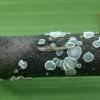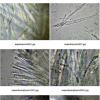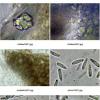
04-11-2025 12:43
 Edvin Johannesen
Edvin Johannesen
Hi! One more found on old Populus tremula log in O

04-11-2025 09:07
Hello.A suspected Hymenoscyphus sprouting on a thi

03-11-2025 21:34
 Edvin Johannesen
Edvin Johannesen
These tiny (0.4-0.5 mm diam.), whitish, short-stip

28-10-2025 15:37
Carl FarmerI'd be grateful for any suggestions for this strik

03-11-2025 16:30
 Hans-Otto Baral
Hans-Otto Baral
Hello I want to ask you if you have found this ye

28-10-2025 19:33
 Nicolas Suberbielle
Nicolas Suberbielle
Bonjour à tous,Je voudrais votre avis sur cette r

31-10-2025 09:19
 Lothar Krieglsteiner
Lothar Krieglsteiner
Can somebody provide me with a file of:Rogerson CT
 Bonsoir à tous,
Bonsoir à tous,Je pense reconnaître ici Mollisia hydrophila sur base de chaume pourri de roseau commun (Phragmites australis).
a) apothécies jaunissant au KOH
b) spores étroitement ellipsoïdes-cylindriques, avec microguttules : 8-10,5x1,5-2,8
c) paraphyses fourchues avec contenu réfringent ou nombreuses guttules
d) masses cristallines dans l'excipulum
Qu'en pensez-vous ?
Bernard


Thank you for the confirmation.
Bernard


Bernard

Following my posting of that thread Nick Aplin in the south of England emailed me - here is a part of that email:
"I've had three collections this year from separate sites in Sussex on Phragmites of what I assume is the same species as yours, but all three have differed only in the abundance of crystals; one had a few very large, irregular crystals, one had many smaller, 'envelope' shaped crystals and in one the crystals were apparently absent . . . . . . All three had the abundant subiculum and also a KOH- reaction. I have wondered whether a correlation can be made between these two characters (especially as all my collections on Phragmites without a subiculum have been distinctly KOH+)."
Chris


Hello,
in former years I have collected many times hydrophila s.l. on Phragmites and have made the same observations. The KOH reaction is sometimes clear to see, sometimes faint, sometimes absent - even in collections from the same location. A subiculum may be present or not. And the crystals may be absent too, although they are usually there.
All in common have the spore shape, which has one spore end blunt and the other pointed.
I have not realized molecular data on more than two collections, which both were quite typical, and which both fell together in the tree. It would be good to have these different collections to see wether it is one variablespecies or a species complex.
best regards,
Andreas

These are interesting results! I hope you have documented the two sequenced ones or noted their peculiarities to allow interpretation of further genetic results.
Zotto



